 |
Picks is a monthly sampling of Japan's art scene, offering commentary by a variety of reviewers about exhibitions at museums and galleries in recent weeks, with an emphasis on contemporary art by young artists. |
 |
 |
 |
3 December 2012 |
 |
| 1 | 2 | |
 |
|
 |
 |
|
|
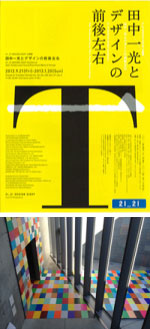 |
 |
 |
 |
| Ikko Tanaka and Future/Past/East/West of Design |
| 21 September 2012 - 20 January 2013 |
21_21 DESIGN SIGHT
(Tokyo) |
 |
| This retrospective on the work of renowned graphic designer Ikko Tanaka (1930-2002) is lavish in the quantity and detail of materials it showcases. Tanaka's creations show the influence of the avant-garde Gutai art movement and its leader, Jiro Yoshihara; his book designs are particularly imaginative. In an era when digitized information was beginning to threaten the physical existence of the book, Tanaka took a fresh look at the way in which printed text and photographs are packaged into the objects we call books. His protégé Masaaki Hiromura designed and organized this show. |
|
 |
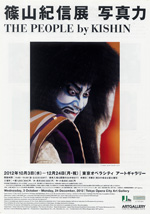 |
 |
 |
|
|
THE PEOPLE by KISHIN
|
| 3 October - 24 December 2012 |
Tokyo Opera City Art Gallery
(Tokyo) |
 |
| Kishin Shinoyama (b. 1940) speaks of the "power of photography," which in his case manifests itself mostly through shots of celebrities. These are faces known throughout Japan, and some charisma does indeed ooze from the images, which Shinoyama sees as the consequence of a kind of divine possession by the photographic gods. Heavy on wall-size color prints, the retrospective is divided into five groups: GOD, STAR, SPECTACLE, BODY, and ACCIDENTS. Except for the last category, which portrays victims of the March 2011 earthquake and tsunami, the overall impression is one of celebrities-on-parade. |
|
|
|
|

|
 |
 |
 |
|
Noe Aoki: All that floats down |
| 13 October - 24 December 2012 |
Toyota Municipal Museum of Art
(Aichi) |
 |
| An installation of monumental works by Aoki, a sculptress who works primarily in iron. The first large gallery contains two creations which, at nearly eight meters in height, are architectural in scale. By contrast, a smaller gallery offers a new work consisting of unwieldy, tottering stacks of used bathing soap that make the space they inhabit seem on the verge of collapse as well. These dialogues with architecture continue throughout the show, concluding with a recent piece, made of plaster, that signifies a startling new direction in Aoki's oeuvre. |
|
|
 |
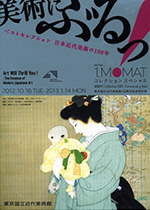 |
|
Art Will Thrill You!: The Essence of Modern Japanese Art |
|
16 October 2012 - 14 January 2013
|
|
The National Museum of Modern Art, Tokyo
(Tokyo) |
 |
| MOMAT celebrates its 60th anniversary with this museum-filling exhibition of Japanese art from the prewar, wartime, and postwar eras, with an emphasis on the sunny contemporary works of the latter period. But this summation only constitutes half of the show; the other half focuses on the fifties. Why just the fifties? Apparently because the museum opened in 1952. As it turns out, though, this section is less an introduction to the art of a particular decade than an attempt to explore the mood of the epoch through a mixture of media, including photography, illustration, and design. One leaves thinking that MOMAT certainly picked a tumultuous era in which to open. |
|
|
|
|
|
|
|

|
 |
 |
|
|
|
|
|
 |
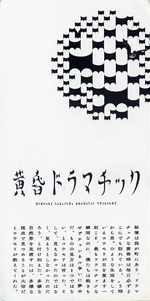 |
 |
|
|
Hiroaki Nakajima: Tasogare Dramatique
|
|
28 September - 4 October 2012
|
FUJIFILM Photo Salon
(Tokyo) |
 |
| Winner of the prestigious Yukio Tabuchi Award for photography in 2010, Nakajima fully exploits the advances in digital technology since the 1990s to produce images of startling clarity, vivid color, and elegant composition. His sequential split-second shots of bats at dusk (tasogare) demonstrate how easily he now clears the technical hurdles of the past. Through his eyes we see not only a discourse on bat ecology, but the unfolding of a story that relates to humanity and Nature at large. |
|
|
|
|
|
|
 |
 |
|
| Sakae Ozawa: Orchestra Under the Water |
| 5 October - 17 November 2012 |
Mori Yu Gallery
(Kyoto) |
 |
| Ozawa's paintings have always been populated with forest creatures and young girls. In her recent works, however, these motifs occupy a less prominent place, edging their way almost diffidently into wildly colorful landscapes or chaotic worlds that emit a whiff of creepiness. In her river-themed series, including How Many Miles to Yesterday's Dream, Kamogawa, and Danube River, female figures sit or stand stoically amid dancing fish, swaying trees, and white flowers -- imagery that insinuates itself into the viewer's own imagination. |
|
 |
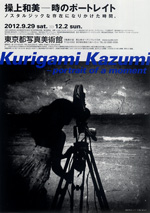 |
 |
|
| Kazumi Kurigami: portrait of a moment |
| 29 September - 2 December 2012 |
Tokyo Metropolitan Museum of Photography
(Tokyo) |
 |
| This show features two series of works by veteran photographer Kurigami (b. 1936). HITOHONE ("Sun and Bone"), shot with a toy camera in the 1970s, consists of grainy, high-contrast monochrome images that capture fragments of the everyday. NORTHERN centers on scenes from Hokkaido, Kurigami's home island, taken after his father died there in 1994, as well as pictures from trips he took with Robert Frank in 1992 and 1994. Both series reveal the keenly honed physiological sensibility of a photographer who has always responded with sensitivity to the interplay of light and shadow, life and death, reality and dreams. |
|
|
|
|
 |
|
|
 |
|